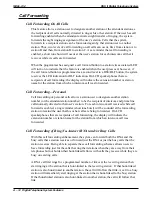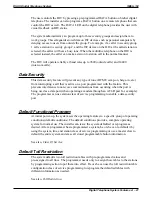
Call Forwarding
Call Forwarding On All Calls
This feature allows a station user to designate another station or the attendant station as
the recipient of all calls normally directed to ring at his or her station. If the user has call
forwarding enabled when the attendant activates night transfer of ringing, the system
forwards the night ringing assignment of the user’s station. Calls that the system
forwards to a recipient station can be forwarded again by that station user to another
station. Thus, two levels of call forwarding on all calls can occur, first, from station A to
station B and then, from station B to station C. As a reminder that call forwarding is
enabled, a short tone burst will occur at the user’s station for each intercom call that it
receives while its calls are forwarded.
When the programmer has assigned a call forward button to a station, its associated LED
will turn on to indicate that the feature is enabled when the user presses it; however, if
the call forward button is programmed as a second level to a DSS/BLF button, the system
reserves the LED indication for BLF indication. On LCD speakerphones that are
recipients of call forwarding, the display will indicate the extension number or station
name for the station from which an intercom call was forwarded.
Call Forwarding—Personal
Call forwarding of personal calls allows a station user to designate another station
number (or the attendant station number) to be the recipient of intercom and prime line
calls normally directed to that user’s station. For each intercom call received while call
forward is enabled, a ring reminder (short tone burst) will be sounded at the forwarding
station to remind the user that his or her calls are being forwarded. On LCD
speakerphones that are recipients of call forwarding, the display will indicate the
extension number or station name for the station from which an intercom call was
forwarded.
Call Forwarding of Ring No-Answer (RNA) and/or Busy Calls
With this call forwarding enhancement, the sytem can forward both the RNA and the
busy calls that a station receives or forward just the RNA or just the busy calls that the
station receives. Being able to separate these call forwarding schemes allows users to
have forwarding just for the calls that ring their stations when they are away from their
telephones but not burden their hunt-linked fellows with calls they receive while they are
busy on existing calls.
A RNA call first rings for a programmed number of times at the receiving station then
start ringing at the station that is hunt-linked to the receiving station. If that hunt-linked
station is also hunt-linked to another station, the call will follow that link. A call to a busy
station will immediately start ringing at the station that is hunt-linked to the busy station.
If that hunt-linked station is also hunt-linked to another station, the call will follow that
link.
IMI66–132
DSU II Digital Telephone System
A – 12 Digital Telephone System Features
Содержание DSU II
Страница 31: ......
















































